The VonHaus Desiccant Dehumidifier impressed me with its clever features - but it has one big downside
I tested the VonHaus Desiccant Dehumidifier to see how it performs in day-to-day life
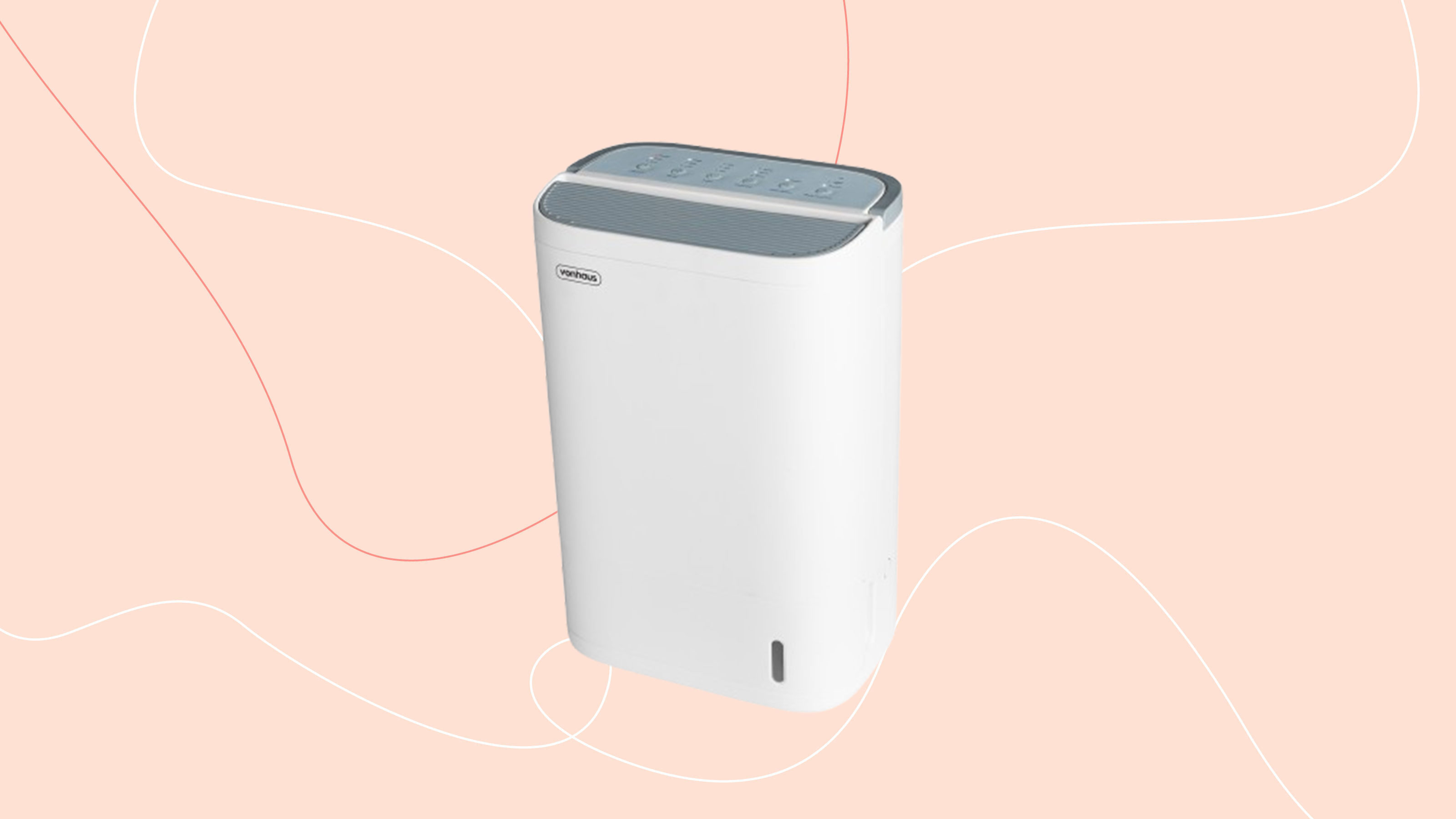
The VonHaus Desiccant Dehumidifier is an easy to use, simple device that gets the job done. We recommend it for anyone looking to reduce moisture and condensation levels in their home, without the hassle of a dehumidifier that needs emptying frequently. It can be quiet as a whisper when used on the lowest setting, and comfortable enough to sleep next to. Our main criticisms are the lack of a lower target humidity setting, and the high cost of running the appliance, which is quite a big consideration to take into account.
-
+
No set-up required
-
+
Quiet to use on low mode
-
+
Ergonomic design
-
+
Lightweight and easily portable
-
+
Comfortable 2.5L tank capacity
-
+
Anion mode removes dust and smells
-
+
Handy timer function
-
+
Anti-tip switch
-
+
Looks aesthetic
-
-
Only quiet when using the low setting
-
-
50% lowest humidity setting
-
-
Quite expensive to run
-
-
No laundry mode
Why you can trust Ideal Home

In this VonHaus Desiccant Dehumidifier review, we put the sleek device through its paces, to see how capable it is at removing moisture from the air. As a dehumidifier that claims to be both quiet and powerful, we wanted to find out if it's going to be a worthy investment for the colder months.
The best dehumidifiers aren't just for homes with condensation issues. Many of our favourite models are also equipped with air-purifying qualities and can be used for indoor laundry drying too. But how does the VonHaus Desiccant Dehumidifier measure up?
VonHaus isn't a huge name in the dehumidifier field, but the brand is known for having some of the most cutting-edge appliances in the garden and kitchen categories. With a 2.5L tank and a 7L extraction rate, the Desiccant Dehumidifier promises to be hassle-free and low maintenance.
Over the past few weeks, I've been testing the Dessicant Dehumidifier in my home, trialling all the different functions in multiple locations. I've used it while watching TV, working from home, doing chores, and even going to sleep, to see how the device fares up in day to day life. Read on to find out all my thoughts about the VonHaus Dehumidifier, and whether I think it's worth the investment.
Specifications
- Type: Desiccant
- Extraction rate: 7L/day
- Water tank capacity: 2.5L
- Max room size recommended: 40m squared
- Noise level: 30 - 50db
- Power: 650W
- Dimensions: H45.5 x W30 x D24cm
- Weight: 5.75kg
- Portable?: Yes
- Automatic humidity sensor: Yes
- Continuous drain option: No
- Laundry mode: No
- WiFi connectivity: No
- Timer: Yes
- Operating temperature: up to 30°C
How I tested

I'm Katie, and I've been writing for Ideal Home as a freelancer for the last two years. I started out supporting the e-commerce team, where I was researching the best products on the market across homes and gardens. I test and review new products in my flat in Leeds, where I live with my partner.
Unboxing

The Desiccant Dehumidifier arrives in one box, which can be easily carried around. The weight of the product is only 5.75kg in total, which is impressive considering the 2.5 litre capacity tank. Getting the dehumidifier out of the box is also made easy thanks to the pick-up handle, so there was no need to awkwardly shuffle it out of the packaging.
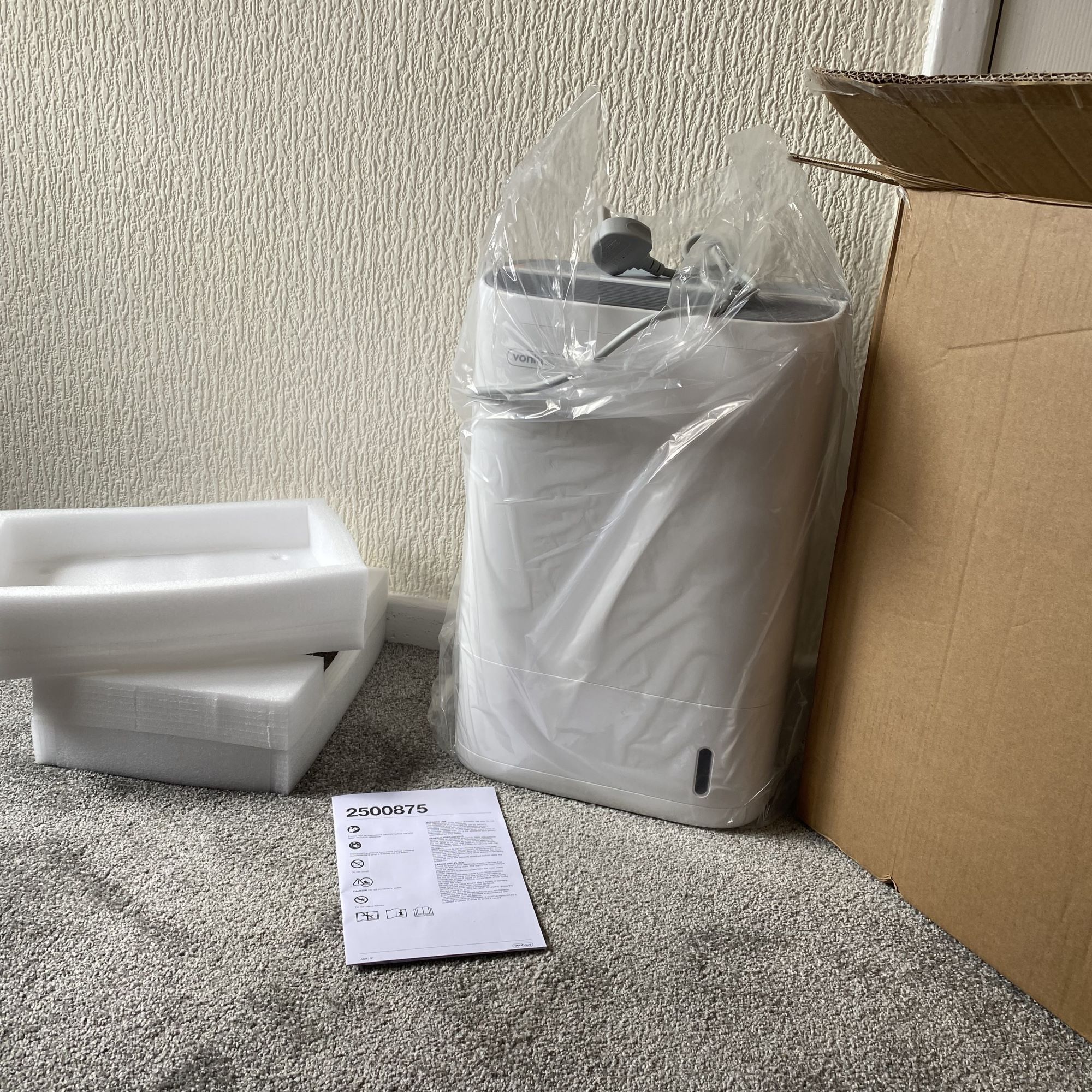
The product was wrapped in a sheet of protective plastic, and wedged in between two polystyrene blocks to keep it safe during transportation. Of course, it would have been nice to see no single-use plastic in the box, but at the same time, I was happy that the dehumidifier arrived in immaculate condition, and that there was only one piece of plastic used.
Set-up
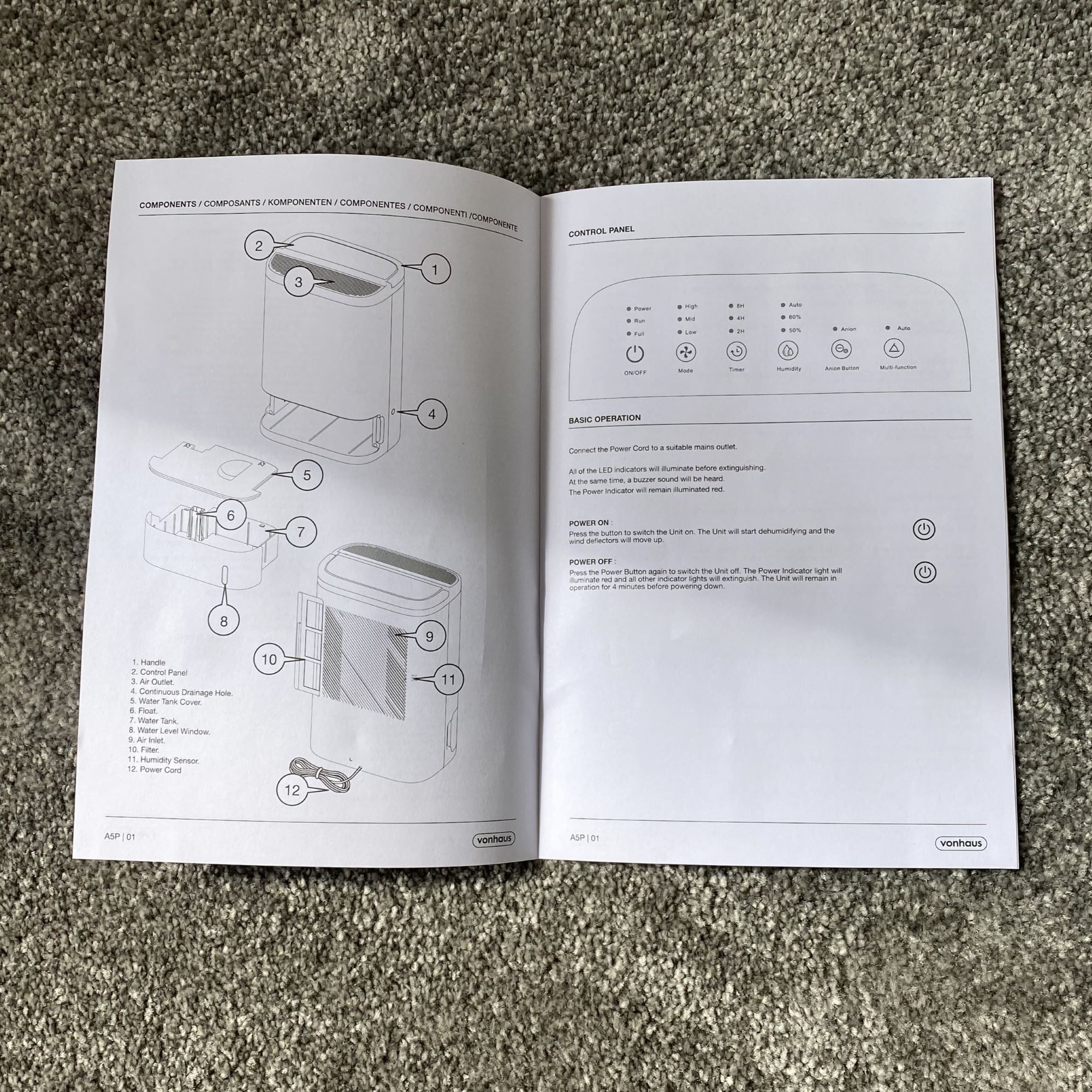
I experienced no problems at all in setting up the VonHaus dehumidifier and putting it to use straight away. All that was required was to remove the packaging, plug the device in and press the power button. I knew it was working because the air outlet opened automatically and a gently whirring noise began.
Sign up to our newsletter for style inspiration, real homes, project and garden advice and shopping know-how
There's still a handy instruction manual included in the box, which has helpful information on the dehumidifier's different modes and features. It also has a diagram which shows you what's what, which would be useful if this is your first time using a dehumidifier.
Design

The dehumidifier's sleek design is one of my favourite things about it. I've had dehumidifiers in the past which look like an eyesore, and I didn't enjoy using them simply because they made my space feel messy. But the VonHaus Desiccant Dehumidifier has a neat look to it that doesn't make it feel lumbersome or clunky.
The body is all white, and the components on top (handle, control panel and air outlet) are grey. Its ergonomic design makes it easy into slip to any corner of the room and let it blend seamlessly with the space. Seeing as dehumidifiers may need to be used in a number of rooms, it's a massive bonus when they're simple and sleek in design, which the VonHaus model definitely is. I even like the subtle VonHaus branding on the front of the device.
Ease of use
The control panel on the top of the dehumidifier can look a little intimidating at first glance, but most of the buttons are pretty self-explanatory. The power button switches the device on and off, and the mode setting lets you select whether you want it to run on high, medium, or low power. There's also a timer button, humidity setting, anion mode and multi-function button, which lets you change the position of the air outlet.
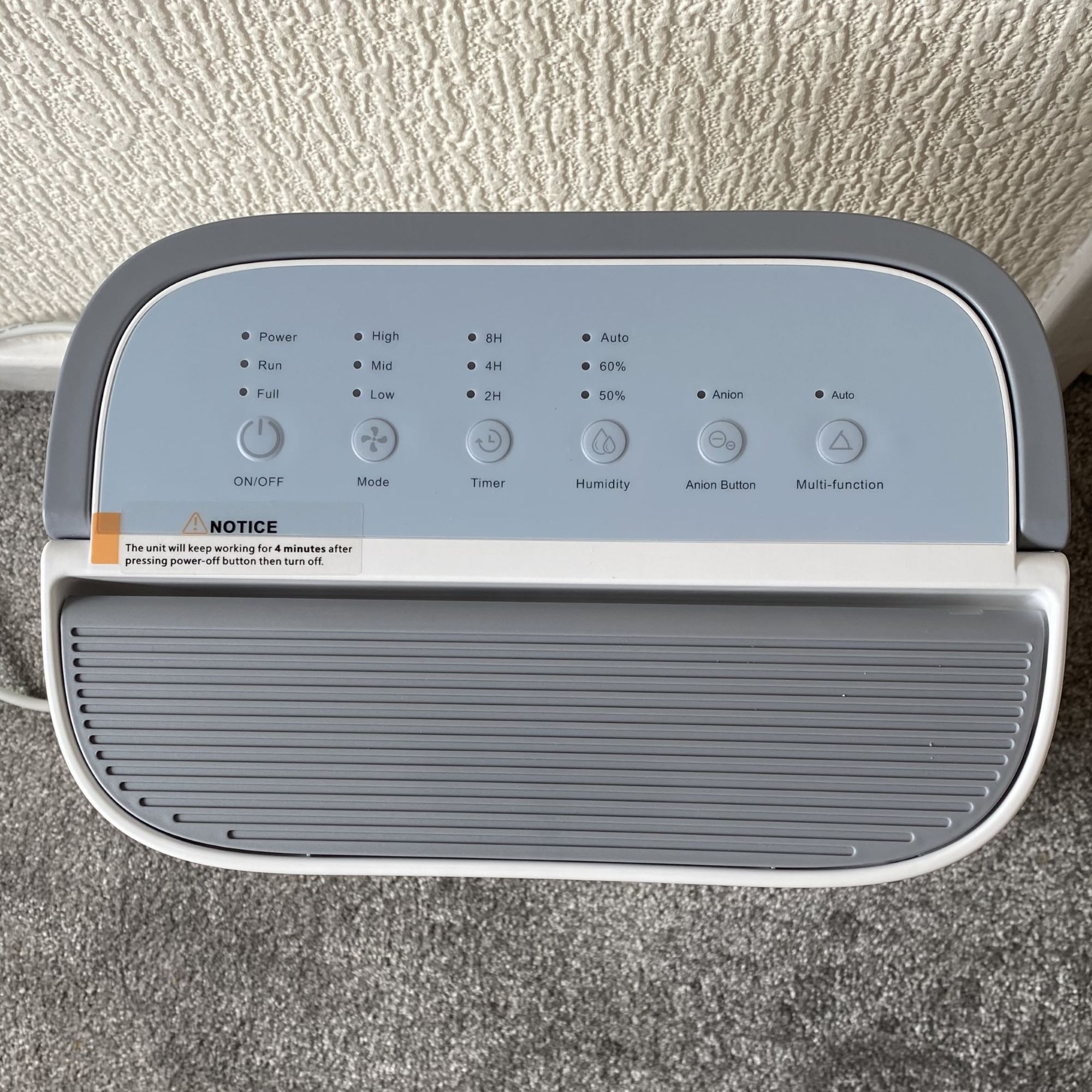
The instruction manual breaks down each button on the control panel, and what they can be used for. This made it super easy to understand how to use the dehumidifier.
Performance
Desiccant dehumidifiers like this one from VonHaus work a little differently from other models as they don't use a refrigerant to condense moisture out of the air. Instead, they use a heater and absorption material to remove moisture from the air.
I wanted to use the VonHaus Desiccant Dehumidifier in multiple locations, to see how well it actually worked. For context, I live on the second floor in a block of flats in quite an old building. Damp and condensation are often rife in my home, especially near windows.
Overall, the dehumidifier did a solid job at removing moisture from the air. I first used it with the timer function, which can set the device to run for either two, four or eight hours. The two hour setting was really handy on days where I wanted to give a specific area a quick refresh, whereas the eight hour setting was perfect for when I was out for the day, but still wanted the device switched on and working. Knowing that it would turn itself off after 8 hours stopped me from worrying about any wasted energy.
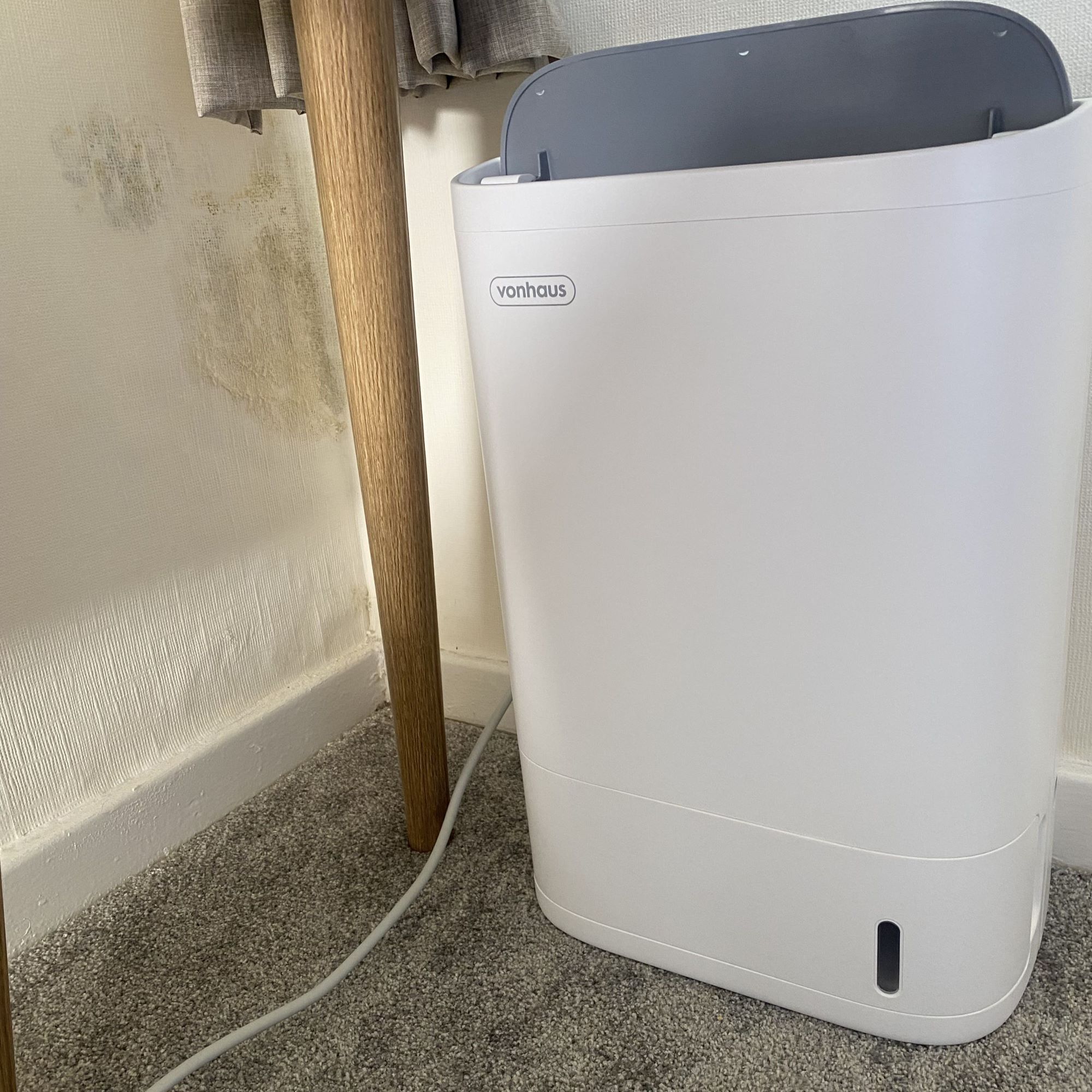
One place I was really intrigued to put the dehumidifier to the test was in the bedroom. As you can see, we're experiencing a bit of a mould problem in the corner of the room underneath my dressing table, so I was keen to see how the VonHaus model fared up in this environment.
Here I tested the humidity setting, which can be set to either 50 or 60% (meaning the device will turn off when the environmental humidity is lower than 50 or 60%). Optimal indoor humidity levels range from 30-50% in the winter, and 40-60% in the summer, so it would have been nice to see an option for a lower humidity setting. The MeacoDry Arete One Dehumidifier for example can be set to reach a target humidity of 40%.
I set the device to 50% humidity and went out for the day. Interestingly, it was still running when I came home, and it had been longer than 8 hours. I would therefore recommend using the humidity setting rather than the timer function when using the dehumidifier in particularly damp areas.
Once the target humidity level was reached, the bedroom certainly felt less moist. I also really liked using the Anion mode at the same time, which removes dust and smells by creating a static charge around airborne contaminants. There was a significant difference in how fresh the room felt afterwards.
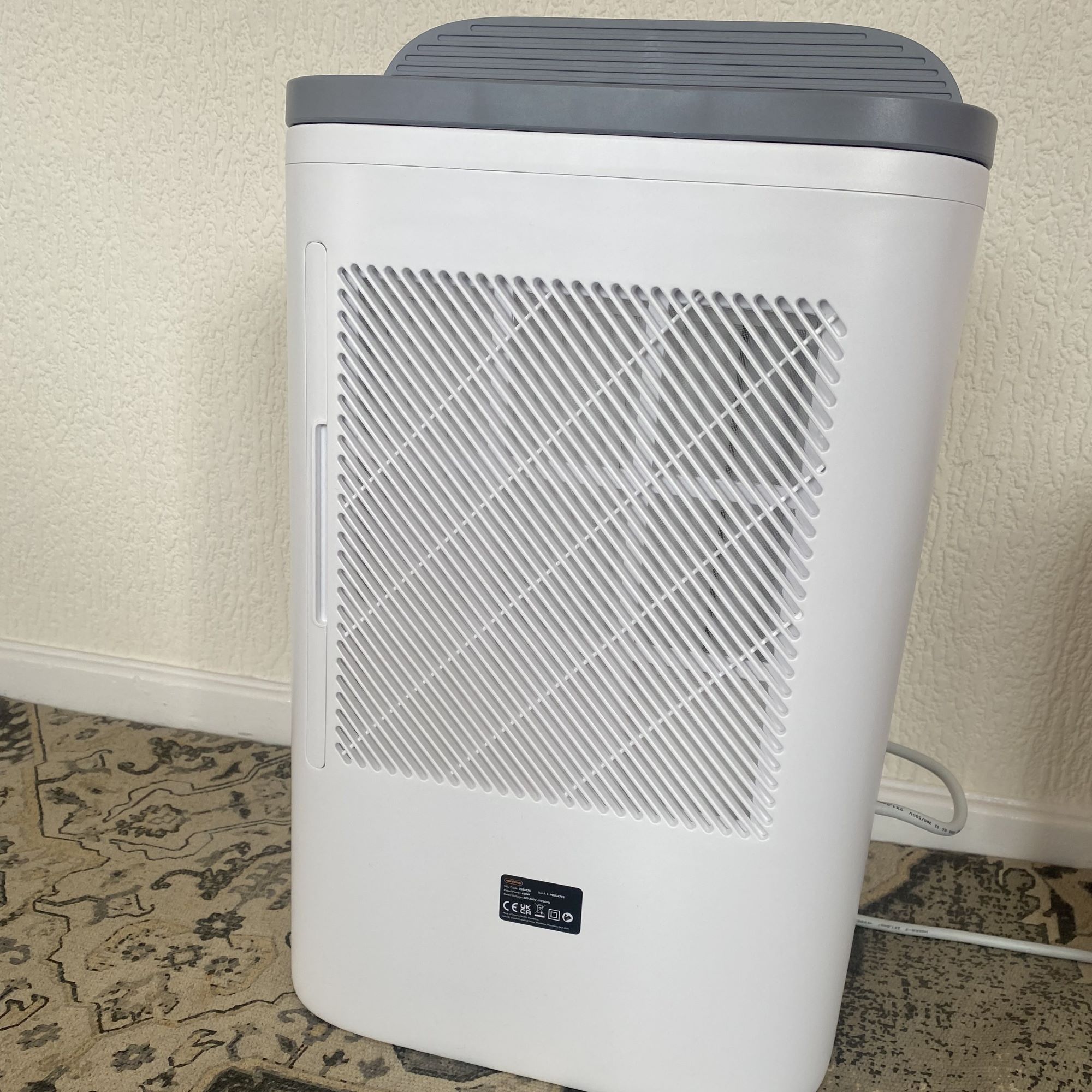
There isn't a laundry mode on the VonHaus Desiccant Dehumidifier, but I did use it while my heated clothes airer was switched on, to see if it made the room feel less moist while clothes were drying. It certainly helped the room feel less stuffy than usual, and I could tell it was doing a good job because it became full at a much quicker rate than other times I'd used it. I would also say that the clothes dried faster with the dehumidifier nearby, though I don't think I would use it to dry clothes by itself - it would probably need to be switched on at least overnight to be able to do this.
I also liked using the dehumidifier to help the creases drop out of clothes. I hung a few items on the wardrobe and placed the dehumidifier nearby, and was pleased at the difference it made. There were a few shirts I put away afterwards because they didn't need to be ironed as well.
There's also a swing button (named Multi-function on the control panel), which can be used to change the position of the wind deflector. Honestly, I didn't see a huge benefit from this. Perhaps it would be helpful if using the dehumidifier to dry clothes and you wanted to direct the air in a certain direction, but I found that having the vent fully open worked best for maximum air flow.

Because I live in an upper floor flat, I didn't have much use for the continuous drainage function. To use this, you'd need a suitable location (i.e. a drain) where you could place the drainage pipe, so the dehumidifier would automatically empty itself and then continue working.
I would say that the pipe provided isn't very long, so the dehumidifier would need to be kept close to the drainage spot when using this function. Also, don't make the mistake I did and continue to use the dehumidifier indoors when the pipe is still connected to the drainage hole - water will leak on to your carpet.
When it came to emptying the dehumidifier, I found the process super easy. The device beeps and stops working when the tank is full, then the compartment slots away easily. It's also covered with a lid so there's less chance of water slopping everywhere when you pull it out, which having had dehumidifiers without this feature in the past, I appreciated.
Thanks to the 2.5L tank, it felt like a good while before I needed to empty it for the first time. Even after running in the bedroom all day, the tank didn't become full, and it's only when using it alongside clothes drying that it needed emptying a bit more frequently.
Energy use
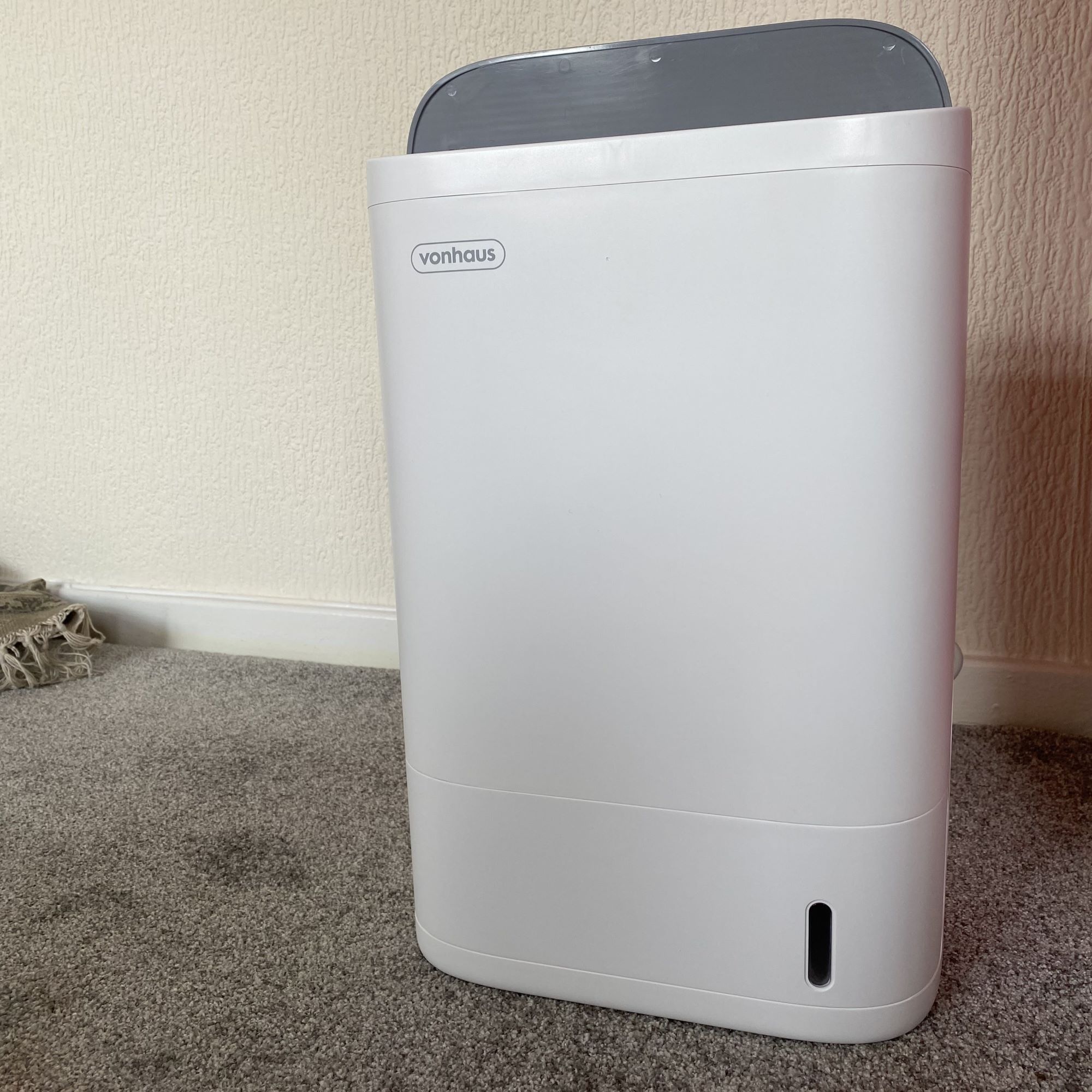
Before purchasing any home appliance, it's important to check its energy usage, which means you're probably wondering how much does a dehumidifier cost to run - and specifically, how much the VonHaus model is going to contribute to your bills.
As far as dehumidifiers go, the VonHaus Dessicant is quite pricey in terms of energy usage. With the current energy price cap set to increase by 10% from October 2024, the dehumidifier will cost 21p per hour to run.
For comparison, the Pro Breeze 12L Low Energy Dehumidifier costs around 7p per hour to run, and the 12L MeacoDry Aerte One Dehumidifier costs around 5p per hour. The VonHaus model is therefore significantly more expensive in terms of energy usage, which I would say is its biggest drawback. Given that this is an appliance I would want to have switched on for significant periods of time, it's not ideal for it to cost as much as it does in terms of energy.
Noise levels
I was relatively happy with the noise levels of the VonHaus Dessicant Dehumidifier. It ranges from 30db on the lowest setting, up to 40db on medium, and 50db on high. On the low setting, I struggled to hear it above the TV, and I didn't mind having it next to me while I was working from home. The gentle whirring noise isn't distracting or annoying, and even my partner agreed he forgot it was switched on sometimes.
Obviously though, there is a noticeable difference in the noise levels when running the device on low compared to high, where it does become significantly louder. I personally didn't enjoy having it running on the medium or high settings when I was in the room, because the noise became too loud to ignore.
As far as dehumidifiers go, I don't think it makes an annoying sound - it's just that the volume seems to ramp up quite a lot when switching from low to medium, and medium to high. However, I wouldn't mind it running on medium or high if I was simply doing chores in the room. It's only if I was trying to relax or sleep when those modes would be a no go.
This is definitely something to keep in mind, especially because the product is called 'Quiet Desiccant Dehumidifier' on the VonHaus website, which is only really true if you're using it on the low setting.
Portability
Thanks to the carry handle, the VonHaus Dessicant Dehumidifier is extremely portable. I had no problems moving the device from room to room when testing, even when it was almost full. The handle also stays put when you lift it up, which I appreciated - my old dehumidifier had a handle that would flop straight back down unless I kept a hold on it.
There aren't any wheels, but honestly, it doesn't need them; the lightweight, ergonomic design gives it full marks for portability.
Maintanence
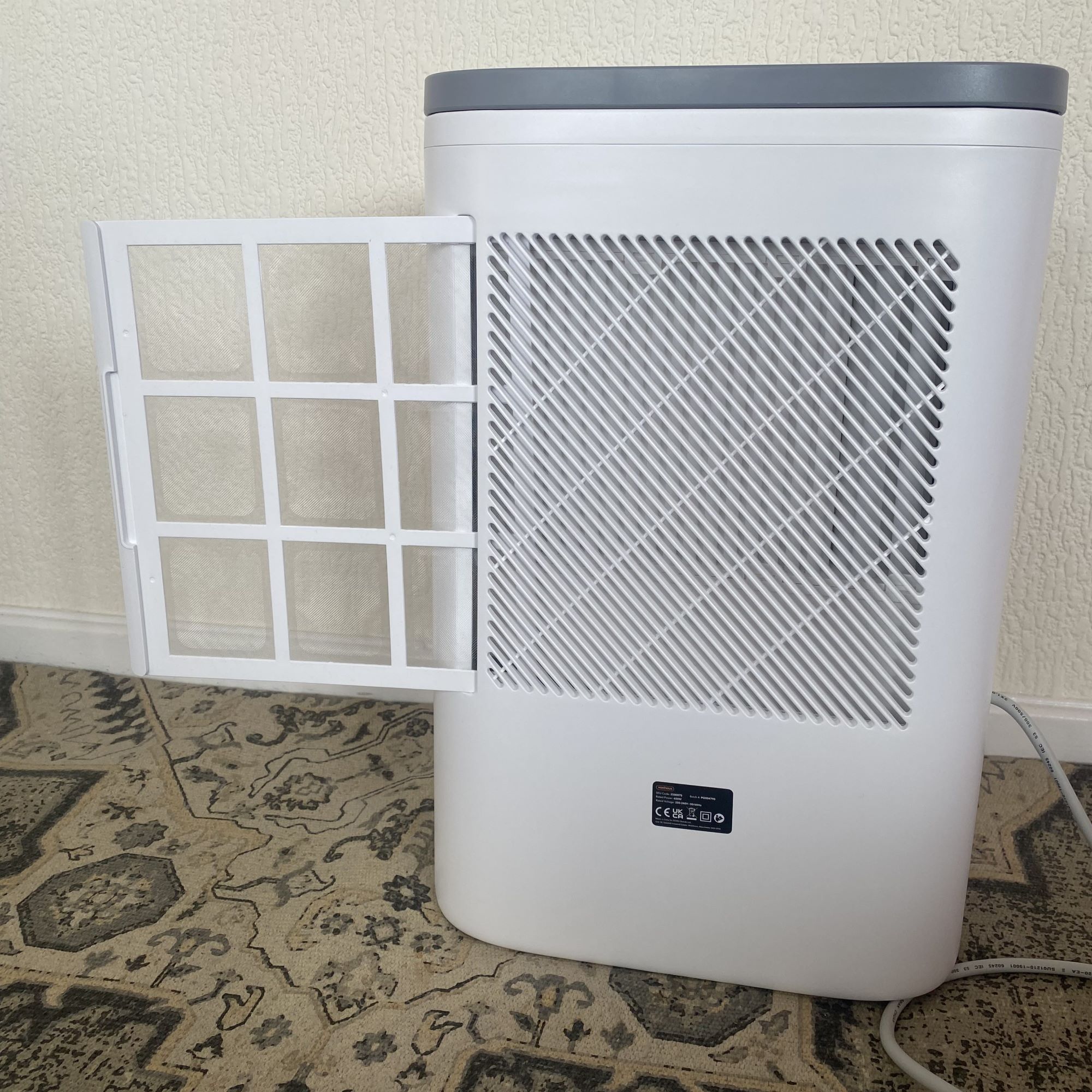
As mentioned before, the VonHaus Dessicant Dehumidifier is really easy to empty. I had no problems emptying the tank into my kitchen sink, as its easy to control the flow of water as you pour it out. And the lid that covers the tank means there was minimal spillage when removing it from the outer body.
Keeping on top of cleaning and maintaining the dehumidifier is also a breeze. The filter slides out from the back easily, and this can be rinsed in warm, soapy water before being left to air dry. It's important to do this regularly, so any dust and debris can be removed and the dehumidifier can continue working optimally.
I also wiped down the outer surfaces fairly regularly, to keep it looking clean. Dust does tend to collect in the air inlet, but it's easy to remove this with a brush.
How does the VonHaus Dessicant Dehumidifer rate online?
Customer reviews of the dehumidifier are mostly positive. It has a rating of 4.1 out of 5 stars on Amazon (from 18 reviews), and users seem generally pleased with the dehumidifier's ability to reduce condensation levels in a room. The large 2.5L tank capacity has also received a lot of praise, and I agree that it's nice not having to manually empty the device frequently.
There are a couple of reviews which state having trouble with the dehumidifier, though I believe these may be due to faulty products. One user said that the machine didn't cut off after the tank was full, meaning water leaked through the ceiling, and another said that the wind deflector got stuck when using the swing button. I didn't experience either of these problems, but obviously it is a concern if some users are receiving a device that doesn't work properly.
Overall though, customers are happy with the product and its ability to serve its purpose. There are some comments about the effectiveness of the device at making cold rooms feel warmer, which is what desiccant dehumidifiers are designed for; I don't have a garage or conservatory, so wasn't able to attest to this personally, but it's good to see that multiple other users have used it for this purpose and been satisfied.
How does it compare to its predecessors?

There are four dehumidifiers available from VonHaus, and the model I tested actually has the lowest extraction rate. If you know that you'd want to leave the dehumidifier running for extended periods of time - e.g. over the course of 24 hours - then you should perhaps consider the VonHaus 20L Dehumidifier. This model has a 24 hour timer and a larger 4L tank, which when used with the continuous drainage pipe, can remove up to 20L of water per day, without you having to touch it. With an Amazon rating of 4.4 out of 5 stars (out of 223 reviews), it has impressed customers.
There's also the Low Energy 12L Dehumidifier available from the brand. Capable of removing up to 12L of water from the environment per day, this model also has a specific laundry mode, so it might be the better choice if this is what you're wanting to use the dehumidifier for. The fact that it claims to be low energy is another advantage over the model I tested, which as we've established, is quite expensive to run.
From a price point perspective, the Desiccant Dehumidifier sits in the middle of the other two models, with the Low Energy 12L device at the cheaper end. That being said, the RRP of the Desiccant model is only £5 less than the 20L Dehumidifier, which isn't a big difference at all when you consider how much larger the latter device is.
Verdict
If you're looking for a dehumidifier that effectively removes moisture from a room, without feeling like an eyesore, the VonHaus Desiccant Dehumidifier could be the ideal choice. What I love most about this model is the sleek, ergonomic design, which aside from making it more attractive than other dehumidifiers, enabled me to move it from room to room with ease.
It can run for extended periods of time without needing to be emptied, and when it does become full, the process doesn't feel like a hassle. And if you're happy to leave the dehumidifier running on the low setting, you'll probably forget that it's even on, thanks to the super quiet noise that it produces.
The caveat to this is that you will likely find it to be a nuisance when it's on either the medium or high setting. The level of noise on either of these settings isn't something most people would be able to sleep with, or relax next to. That being said, most dehumidifiers will make a loud noise when you put them on full whack, as it's the only way they can really work.
The Anion mode is a nice additional feature, which effectively cleans the room by removing contaminants from the air. One of my main criticisms is that the lowest humidity setting is 50%. As we head into the colder months, I think a device with a lower humidity setting (of 45 or even 30%), would be better for homes that experience a lot of condensation.
With an RRP of £174.99, the VonHaus Desiccant Dehumidifier feels reasonably priced. The EcoAir Simple Desiccant Dehumidifier is priced at £229.98 for example, though this one would be cheaper to run and is effective at drying clothes, as tried and tested by us. The VonHaus model is also significantly cheaper than the Meaco Arete Two Dehumidifier (RRP £299.99), which holds the top spot in our buying guide for best dehumidifier overall. But the Meaco model is low-energy, excellent at drying clothes, and has Wi-Fi connectivity and Smart compatibility - features that are sadly lacking in the VonHaus model.
That being said, the MeacoDry Arete One 12L Dehumidifier falls at a similar price point (RRP £179.99), though this comes with a dedicated laundry mode and is a lot more energy-efficient than the VonHaus model. So it seems like there are definitely other options that could get you more for your money.
Overall, the VonHaus Desiccant Dehumidifier performs well and is easy to use. I'd recommend it for anyone looking to purchase a dehumidifier that is simple and no-fuss. It can be quiet as a whisper, and has the added bonus of purifying the air too. But, be prepared to see a noticeable increase in your energy bills if you're going to be using it all the time. There are alternative models on the market that are cheaper to run, with the addition of a laundry mode as well, so I'd suggest shopping around if this is what you're interested in.

Katie has been writing freelance since early 2022, specialising in all things homes and gardens, following achieving a Masters in Media and Journalism. She started out writing e-commerce content for several of Future’s interior titles, including Real Homes, Gardeningetc, Livingetc, and Homes and Gardens. Since then she’s been a regular contributor on Ideal Home’s digital team, covering news topics, how-to guides, and product reviews.